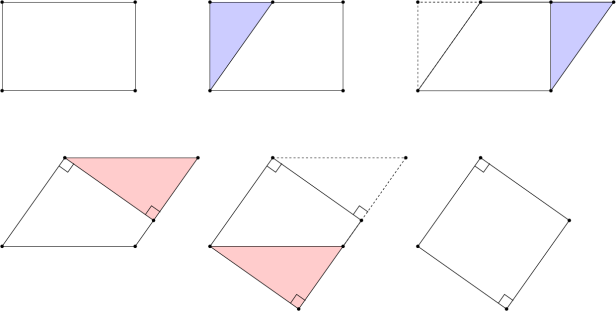This post is simply a reworking of my previous post on this subject as I realized I had missed a special case which is accounted for in a single line but which nevertheless had gone unmentioned. The problem was to start with a rectangle of dimensions , naturally having area
and cutting it apart into pieces which are then rearranged to form a square with the same area.
This procedure involves abusing the knowledge that the resulting square will have as the lengths of its sides where you start by cutting a ‘pseudo-diagonal’ having this length across the rectangle, having sliced of a triangular corner. Displacing this corner to the other side of the rectangle you obtain a parallelogram with
as its base and implicitly also
as its height by virtue of the known area. This parallellogram is then cut along on of it’s altitudes normal to the side with length
and rearranging this pieve the resulting shape is a square. Diagrammatically the procedure is shown below.
 Note 1: There were two things I wanted to expand on regarding this procedure. Firstly that it needs to be supplied an additional step if the rectangle is too wide. More precisely if the base is more than twice the height.
Note 1: There were two things I wanted to expand on regarding this procedure. Firstly that it needs to be supplied an additional step if the rectangle is too wide. More precisely if the base is more than twice the height. If that is the case an additional cut will be required. We may first note the limiting case
where the second cut now intersects with one of the corners
and if the width is increased beyond this limit our desired seond piece is only partially contained in the actual paralellogram. You see pretty much immediately that all you need is to move this piece and then slice of a tip segment and move that but it’s nevertheless an additional step which should have been noted upon.
Note 2: The second thing I wished to expand upon was simply argument for the fact that this actually forms a square. Knowing all the formulas for area it is pretty easy to fill in all the blanks such as that parallelogram with area and and base
must have height $a$ or if a rectangle has area
and base $b$ then its height would be
and so on.
However it would be much neater to take this rearrangement as the proof that the area of a recangle with sides $a\times b$ has area . To outline this proof I will make use of this particular definition of area:
If a geometrical figure can be cut into a finite number of smaller pieces and rearranged into the shape of a square with side we say that the figure has area
.
This is not a complete definition of area as what constitutes a ‘piece’ and ‘rearranged’ is unclear and not all figures are necessarily rearrangeable and like all casual definitions it might invite paradoxes but it allows us to form a class of figures which we say have equal area and make more practical sense of that means instead of just memorizing formulas. For example to say an A4 paper has an area of 623.7 cm^2 now means it can be cut and rearranged into a square with a $\sqrt{623.6} = 27.97$ cm side.
The part of the dissection which I would like to prove without references to area that the resulting shape really is a square. With reference to the diagram below we say we have a parallelogram height and base
so such that it’s slanted side has length
and wish to show that the altitude normal to DC goign through B, BE, also is

This is most easily proven using the similarity of the two triangles AEB and EDB which follows from the angles A and C in a paralellogram being equal. From this we get
and thus
Therefore it is truly a square that the rectangle is being rearranged into and just to be needlessly pedatic lets once again note that all this meant that a rectangle with dimensions was possible to rearrange into a square with side
meaning the area of the rectangle really is
!
Sidenote: What jogged my memory on was that I’ve been thumbing through this Peter R: Cromwells rather charming book Polyhedra where the problem of how you might define volume partially (but ultimately not exclusively) though dissection sprang to mind. On page 45 I also recovered another outline of how to dissect a general polygon to a square though with a different final step than my own and for whatever reason omitting the step outline above. In principle you should be able to perform this dissection ‘face wise’ to prove the volume formula of a prism (or rather the cuboid) but I’ve yet to complete the details of the proof.

